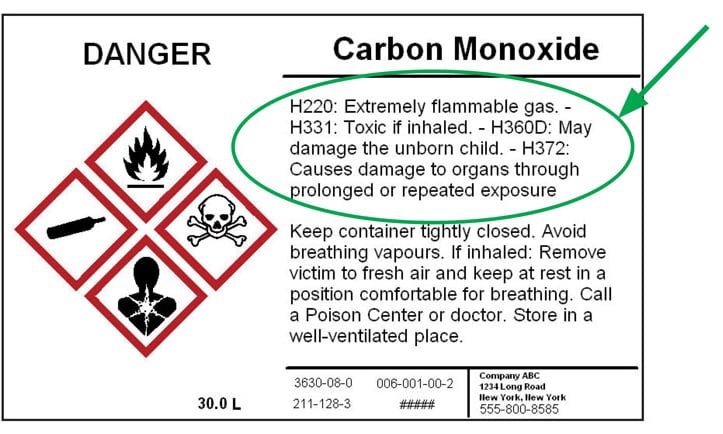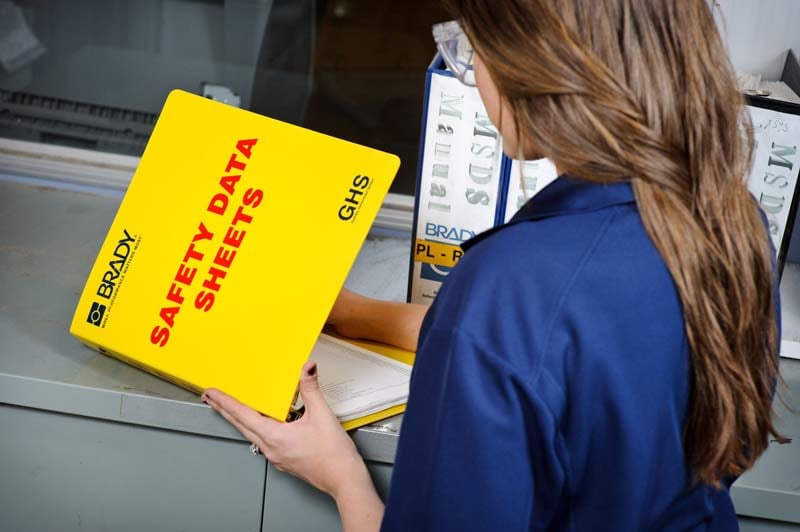List of GHS Hazard Statements and How to Choose
Clear, brief and easily translatable – these three characteristics are baked into all GHS hazard statements, and for good reason. Because a fast-paced world doesn’t slow down for handling of hazardous chemicals. Learn more about how these important identifiers fit into overall GHS labeling and how to identify GHS hazard statements you need.
What is a GHS hazard statement?
GHS label hazard statements are phrases that describe the nature of hazardous products and the degree of hazard. They’re further organized and identified by GHS hazard statement codes, or H codes. Learn more about GHS labeling requirements, elements and 2022 updates.
Hazard statements are part of the Globally Harmonized System (GHS) of Classification and Labeling of Chemicals. The OSHA Hazard Communication Standard (HCS) is aligned with this international system, now known as HazCom 2012. GHS hazard statements make up one of the six elements of a compliant GHS label, which include:
- Signal Word (DANGER or WARNING)
- GHS Symbols (globally identifiable pictograms)
- Manufacturer Information (name, address, phone number)
- Precautionary Statements / First Aid (preventive, response, storage or disposal precautions)
- Hazard Statements (nature and degree of hazard)
- Product Name (product, chemical or other Identifier)

A GHS hazard statement includes the nature and degree of hazard.
Determining a chemical’s hazard statement
To determine a chemical’s GHS hazard statement, you’ll need to know the chemical’s GHS hazard class and GHS hazard category. These are provided in Section 2 (Hazard Identification) of a Safety Data Sheet (SDS).
- A GHS hazard class defines the nature of a physical or health hazard by grouping together products that have similar properties, e.g., flammable solid, carcinogenicity or acute toxicity.
- A GHS hazard category provides a numerical representation of the hazardous severity of the product from 1 through 4, with 1 denoting the greatest severity of hazard.
GHS hazard statements are based on a chemical’s hazard class and category. Once you know these, you can cross-reference the required hazard statement.

List of GHS label hazard statements and H codes
Each GHS hazard statement is designated an H code, which starts with the letter H and is followed by 3 digits (H_ _ _). These are for reference purposes only and most useful to assist in translation. While they may appear on a GHS label, the hazard statements are what are required to appear.
Physical Hazards (H2_ _)
| H200 | Unstable explosive |
|---|---|
| H201 | Explosive; mass explosion hazard |
| H202 | Explosive; severe projection hazard |
| H203 | Explosive; fire, blast or projection hazard |
| H204 | Fire or projection hazard |
| H205 | May mass explode in fire |
| H206 | Fire, blast or projection hazard; increased risk of explosion if desensitizing agent is reduced |
| H207 | Fire or projection hazard; increased risk of explosion if desensitizing agent is reduced |
| H208 | Fire hazard; increased risk of explosion if desensitizing agent is reduced |
| H220 | Extremely flammable gas |
| H221 | Flammable gas |
| H222 | Extremely flammable aerosol |
| H223 | Flammable aerosol |
| H224 | Extremely flammable liquid and vapour |
| H225 | Highly flammable liquid and vapour |
| H226 | Flammable liquid and vapour |
| H227 | Combustible liquid |
| H228 | Flammable solid |
| H229 | Pressurized container: may burst if heated |
| H230 | May react explosively even in the absence of air |
| H231 | May react explosively even in the absence of air at elevated pressure and/or temperature |
| H232 | May ignite spontaneously if exposed to air |
| H240 | Heating may cause an explosion |
| H241 | Heating may cause a fire or explosion |
| H242 | Heating may cause a fire |
| H250 | Catches fire spontaneously if exposed to air |
| H251 | Self-heating; may catch fire |
| H252 | Self-heating in large quantities; may catch fire |
| H260 | In contact with water releases flammable gases which may ignite spontaneously |
| H261 | In contact with water releases flammable gas |
| H270 | May cause or intensify fire; oxidizer |
| H271 | May cause fire or explosion; strong oxidizer |
| H272 | May intensify fire; oxidizer |
| H280 | Contains gas under pressure; may explode if heated |
| H281 | Contains refrigerated gas; may cause cryogenic burns or injury |
| H290 | May be corrosive to metals |
Health Hazards (H3_ _)
| H300 | Fatal if swallowed |
|---|---|
| H301 | Toxic if swallowed |
| H302 | Harmful if swallowed |
| H303 | May be harmful if swallowed |
| H304 | May be fatal if swallowed and enters airways |
| H305 | May be harmful if swallowed and enters airways |
| H310 | Fatal in contact with skin |
| H311 | Toxic in contact with skin |
| H312 | Harmful in contact with skin |
| H313 | May be harmful in contact with skin |
| H314 | Causes severe skin burns and eye damage |
| H315 | Causes skin irritation |
| H316 | Causes mild skin irritation |
| H317 | May cause an allergic skin reaction |
| H318 | Causes serious eye damage |
| H319 | Causes serious eye irritation |
| H320 | Causes eye irritation |
| H330 | Fatal if inhaled |
| H331 | Toxic if inhaled |
| H332 | Harmful if inhaled |
| H333 | May be harmful if inhaled |
| H334 | May cause allergy or asthma symptoms or breathing difficulties if inhaled |
| H335 | May cause respiratory irritation |
| H336 | May cause drowsiness or dizziness |
| H340 | May cause genetic defects |
| H341 | Suspected of causing genetic defects |
| H350 | May cause cancer |
| H351 | Suspected of causing cancer |
| H360 | May damage fertility or the unborn child |
| H361 | Suspected of damaging fertility or the unborn child |
| H361d | Suspected of damaging the unborn child |
| H362 | May cause harm to breast-fed children |
| H370 | Causes damage to organs |
| H371 | May cause damage to organs |
| H372 | Causes damage to organs through prolonged or repeated exposure |
| H373 | May cause damage to organs through prolonged or repeated exposure |
Environmental Hazards (H4_ _)
| H400 | Very toxic to aquatic life |
|---|---|
| H401 | Toxic to aquatic life |
| H402 | Harmful to aquatic life |
| H410 | Very toxic to aquatic life with long-lasting effects |
| H411 | Toxic to aquatic life with long-lasting effects |
| H412 | Harmful to aquatic life with long-lasting effects |
| H413 | May cause long-lasting harmful effects to aquatic life |
| H420 | Harms public health and the environment by destroying ozone in the upper atmosphere |
| H441 | Very toxic to terrestrial invertebrates |
European Union Supplementary Hazard Statements List
In addition to these hazard statements, European Union Regulation (EC) No 1272/2008 - Classification, Labelling and Packaging of Substances and Mixtures (CLP) kept many hazard statements not part of GHS. These include:
EU Hazards (EUH_ _ _)
| EUH001 | Explosive when dry |
|---|---|
| EUH006 | Explosive with or without contact with air |
| EUH014 | Reacts violently with water |
| EUH018 | In use, may form flammable/explosive vapour-air mixture |
| EUH019 | May form explosive peroxides |
| EUH044 | Risk of explosion if heated under confinement |
| EUH029 | Contact with water liberates toxic gas |
| EUH031 | Contact with acids liberates toxic gas |
| EUH032 | Contact with acids liberates very toxic gas |
| EUH066 | Repeated exposure may cause skin dryness or cracking |
| EUH070 | Toxic by eye contact |
| EUH071 | Corrosive to the respiratory tract |
| EUH059 | Hazardous to the ozone layer |
| EUH201 | Contains lead. Should not be used on surfaces liable to be chewed or sucked by children |
| EUH201A | Warning! Contains lead |
| EUH202 | Cyanoacrylate. Danger. Bonds skin and eyes in seconds. Keep out of the reach of children |
| EUH203 | Contains chromium (VI). May produce an allergic reaction |
| EUH204 | Contains isocyanates. May produce an allergic reaction |
| EUH205 | Contains epoxy constituents. May produce an allergic reaction |
| EUH206 | Warning! Do not use together with other products. May release dangerous gases (chlorine) |
| EUH207 | Warning! Contains cadmium. Dangerous fumes are formed during use. See information supplied by the manufacturer. Comply with the safety instructions |
| EUH208 | Contains (name of sensitising substance). May produce an allergic reaction |
| EUH209 | Can become highly flammable in use |
| EUH209A | Can become flammable in use |
| EUH210 | Safety data sheet available on request |
| EUH401 | To avoid risks to human health and the environment, comply with the instructions for use |
